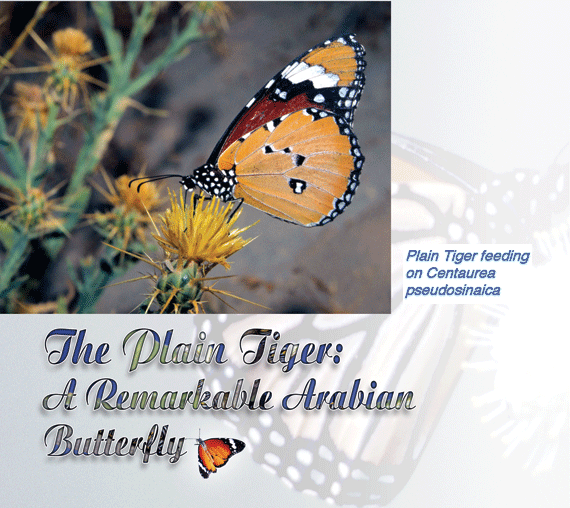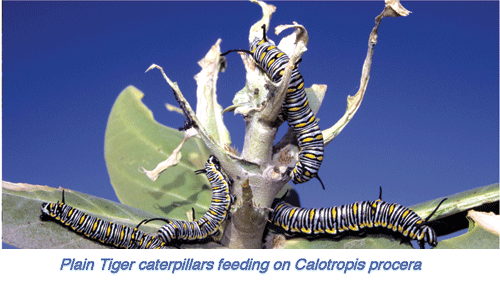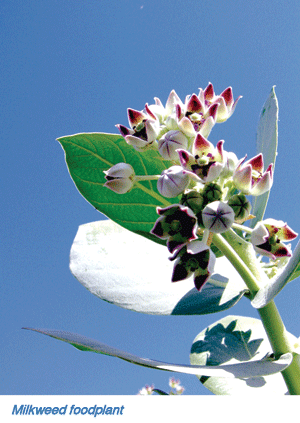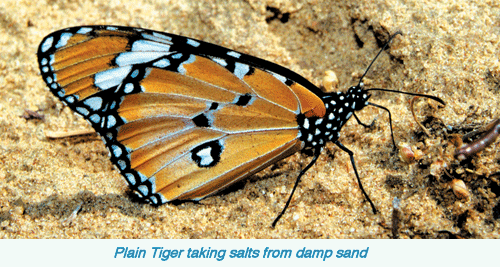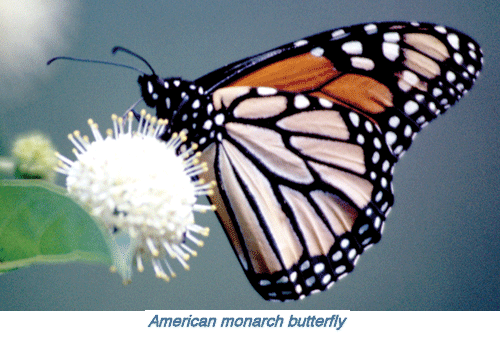|
NATURE |
|
|
Written and photographed by Dr. Graham Lobley
![]()
 arge and conspicuous, the plain tiger butterfly is a member of the
monarch butterfly family and is common across Arabia. Unpalatable to
predators owing to the toxic diet of its caterpillars, it is
faithfully mimicked by an unrelated butterfly, the diadem. It
readily drinks nectar, especially from natural desert flowers, but
opportunistically also takes in salts from damp soils.
arge and conspicuous, the plain tiger butterfly is a member of the
monarch butterfly family and is common across Arabia. Unpalatable to
predators owing to the toxic diet of its caterpillars, it is
faithfully mimicked by an unrelated butterfly, the diadem. It
readily drinks nectar, especially from natural desert flowers, but
opportunistically also takes in salts from damp soils.
Widespread
Adult plain tiger butterflies are on the wing in Arabia for about half the year, from September to June. In the extremely hot summers, they exist primarily as pupae, ready to hatch when the weather begins to cool. They are very common in the winter months - the plain tiger pictures featured in this article were all taken in Dhahran in Eastern Saudi Arabia over several years, between November and May. The butterfly is widespread in the old world tropics and subtropics, ranging from Australasia and China to Arabia and Africa.
Striking patterns signal danger
The plain tiger butterfly is a rich, honey brown colour, with jet black tips on the forewings broken by a prominent white bar. This vivid pattern, coupled with its slow flight, would seem to present an easy target for birds. In fact, its bright colours are a strong warning, and the leisurely flight is designed to ensure that birds notice the colours. Experiments have revealed that captive birds quickly learn to avoid eating plain tigers and apparently transmit this knowledge to other birds. Though a few plain tiger butterflies do get killed, their sacrifice protects the rest of their family - since the birds will never touch another plain tiger.
|
|
Ancient Egyptian connection
Butterflies have been appreciated throughout human history. In particular, the ancient Egyptians used them in their artwork. The plain tiger captured the interest of an unknown Egyptian artist working in Thebes some 3500 years ago, when he painted a fresco that included seven butterflies: the earliest recognisable butterfly art. The butterfly is still common today in modern Egypt. Entomologist Torben Larsen went further in his article on The Butterflies of Egypt (1994), remarking that '...it is somewhat ironic that the oldest painting of a butterfly should be from Egypt, one of the poorest habitats for butterflies anywhere in the world.'
However, some sources suggest that the climate in both Arabia and the Nile Valley may have been considerably wetter a few thousand years ago, so in fact the habitat may have been appreciably better then. Nonetheless, this butterfly is a great survivor since it can cross deserts and colonise new breeding areas in oases.
Model for mimicry
Despite the fact that it is widespread in Arabia, the plain tiger Danaus chrysippus is probably the most fascinating butterfly of the Peninsula. Because it is unpalatable and poisonous, its colouring is faithfully copied by the female of a non-poisonous species: the diadem Hypolimnas misippus, a species which is quite common in the west and southwest of the Kingdom, including urban Jeddah. This practice, known as mimicry, is widespread in the animal kingdom: a harmless species imitates a dangerous species, thereby deriving protection from predators.
|
The plain tiger caterpillars feed exclusively on plants of the milkweed family (Ascepiadaceae), notably Calotropis procera, which contain powerful cardiac toxins. When broken, these plants ooze a sticky white substance which is poisonous. The Bedouin use the fluid as a herbal medicine for heart ailments in the same way that foxglove Digitalis was used in Europe. The brightly-coloured caterpillars sequester the poisons of Calotropis, which are subsequently transferred to the adults in concentrated form. The striking caterpillar is banded black and yellow on white and has three projecting pairs of filaments. Their dramatic appearance is thought to be a warning to potential predators of their unpleasant taste. |
|
Relative of the American monarch
The plain tiger butterfly is a migrant, closely related to the American monarch Danaus plexippus, perhaps the most impressive migrant of all. The plain tiger ranges into the Mediterranean, while the American monarch butterfly very rarely reaches Western Europe. The American monarch is also established as a localised resident in southern Spain, notably near Malaga. Uniquely in the Canary Islands, both species are now established residents in coastal areas.
Reflecting its similarity to the American monarch, in Southern Africa at least, the vernacular name of the plain tiger is African monarch (Clive Quickelberge, Familiar South African Butterflies, 1994).
Pheromones and heliotropes
The plain tiger is hard to miss as it flutters about, frequently alighting on flowers. In Arabia, the plain tiger often feeds on the tiny white Heliotropium ramosissimum and yellow Centaurea pseudosinaica flowers. The cardiac poisons that create its unpalatability are not the only chemicals involved in the life cycle of this remarkable butterfly. The male has to dust the female in a special scent or pheromone before mating, which means finding the plants and shrubs which contain the necessary substances from which to synthesise it. In Arabia, this is thought to be mainly the Heliotropium family, of which there are at least ten different plant species.
|
|
Nectar and other nutrients
As with most butterflies, the plain tiger is strongly attracted to flower nectar. Other nutrients may also include minerals and salts obtained from damp patches of earth. I have photographed plain tigers in Dhahran drinking from damp sand after heavy rain. At Dhi Ain, a beautiful old oasis in the mountains below Baha in Western Saudi Arabia, I also observed plain tigers drinking from the wet sides of irrigation channels.
Arabia: Sand, Sea, Sky
Other butterflies commonly visit damp patches in the tropics, where huge numbers can sometimes be found at the sides of streams. The same phenomenon has also been reported from temperate regions, such as Europe. Other Arabian butterflies, such as the African lime Papilio demoleus, are also known to visit damp patches. In the beautifully filmed and highly recommended video version of Michael McKinnon's Arabia: Sand, Sea, Sky (1990), many beautiful African lime butterflies are shown drinking from damp patches beside a mountain pool. The narrative suggests that they are extracting organic mineral nutrients.
|
|
